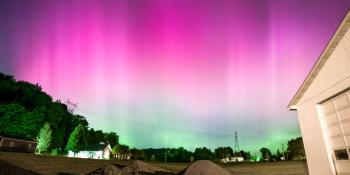Viewing archive of czwartek, 1 lutego 2001
Raport aktywności słonecznej
Any mentioned solar flare in this report has a scaling factor applied by the Space Weather Prediction Center (SWPC). Because of the SWPC scaling factor, solar flares are reported as 42% smaller than for the science quality data. The scaling factor has been removed from our archived solar flare data to reflect the true physical units.
Raport aktywności słoneczno- geomagnetycznej 2001 Feb 01 2200 UTCPrzygotowane przez NOAA © SWPC i przetworzone przez SpaceWeatherLive.com
Połączenie raportów USAF/NOAA o słonecznej i geofizycznej aktywności
Numer SDF 032 wydany w 2200Z na 01 Feb 2001IA. Analiza aktywności regionów słonecznych i aktywność od 31-2100Z do 01-2100Z Solar activity has been low. Region 9330 (N25E54)
produced a C7/Sf flare at 01/0712 UTC and two lesser C-class events
during the period. This region remains the largest and most active
on the visible disk. Two new regions were numbered today: 9333
(N24W10) and 9334 (N12E78). Region 9333 developed with rapid growth
but produced no significant activity. Region 9334 rotated onto the
visible disk today and produced some subfaint optical flares, but
without any notable x-ray enhancements. Other active regions on the
visible disk were mostly stable and quiet.
IB. Prognoza aktywności słonecznej
Solar activity is expected to be
predominantly low for the next three days. Region 9330 is a
potential source for isolated M-class flares.
IIA. Podsumowanie aktywności geofizycznej 31-2100Z do 01-2100Z
The geomagnetic field has been quiet to unsettled throughout the day,
in the wake of the geomagnetic storm activity of January 31. A
trend toward mostly quiet conditions has been evident for the latter
half of the period.
IIB. Prognoza aktywności geofizycznej
The geomagnetic field is
expected to be predominantly quiet with isolated unsettled periods
for the next three days, barring the occurrence of an earth-directed
CME.
III. Prawdopodobieństwa zdarzenia 02 Feb do 04 Feb
| Klasa M | 35% | 35% | 35% |
| Klasa X | 05% | 05% | 05% |
| Proton | 01% | 01% | 01% |
| PCAF | green | ||
IV. Przepływ 10,7 cm z Penticton
Zaobserwowano 01 Feb 161 Przewidywane 02 Feb-04 Feb 165/165/170 Średnia z 90 dni 01 Feb 172
V. Indeks geomagnetyczny A
Zaobserwowano Afr/Ap 31 Jan 011/018 Szacowane Afr/Ap 01 Feb 006/007 Przewidywane Afr/Ap 02 Feb-04 Feb 005/005-005/005-007/007
VI. Prawdopodobieństwa aktywności geomagnetycznej 02 Feb do 04 Feb
| A. Średnie szerokości geograficzne | |||
|---|---|---|---|
| Aktywne | 25% | 25% | 25% |
| Słaba burza | 05% | 05% | 05% |
| Bardzo znacząca burza | 01% | 01% | 01% |
| B. Wysokie szerokości geograficzne | |||
|---|---|---|---|
| Aktywne | 25% | 25% | 25% |
| Słaba burza | 05% | 05% | 05% |
| Bardzo znacząca burza | 01% | 01% | 01% |
All times in UTC
<< Idź do codziennego przeglądu
Najnowsze wiadomości
Najnowsze wiadomości z forum
What makes AR3684 magnetically distinct from AR3685? 5Filaments and prominences 127Unproven theories 481AR3664 1072AR3685 53
Więcej tematówWesprzyj SpaceWeatherLive.com!
Wielu ludzi odwiedza SpaceWeatherLive aby śledzić aktywność słoneczną lub sprawdzić czy jest szansa na zaobserwowanie zorzy polarnej. Niestety, większy ruch na stronie oznacza większe koszty utrzymania serwera. Dlatego, jeśli jesteś zadowolony ze strony SpaceWeatherLive, zachęcamy do wspierania nas finansowo. Dzięki temu będziemy mogli utrzymać naszą stronę.

Fakty na temat pogody kosmicznej
| Ostatnie rozbłyski klasy X | 2024/05/15 | X2.9 |
| Ostatnie rozbłyski klasy M | 2024/05/17 | M7.1 |
| Ostatnia burza geomagnetyczna | 2024/05/17 | Kp6 (G2) |
| Spotless days | |
|---|---|
| Ostatni dzień bez skazy | 2022/06/08 |
| Monthly mean Sunspot Number | |
|---|---|
| kwietnia 2024 | 136.5 +31.6 |
| maja 2024 | 157.2 +20.7 |
| Last 30 days | 171.9 +57.9 |


